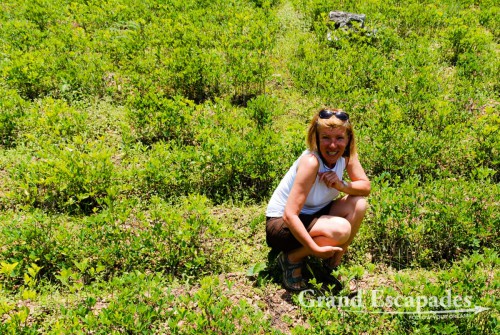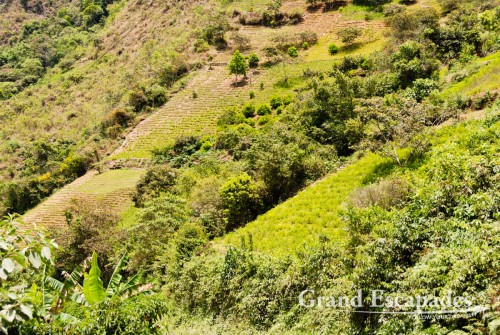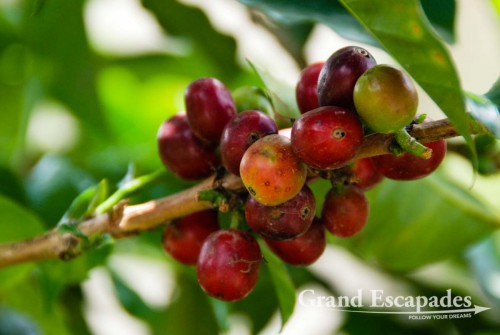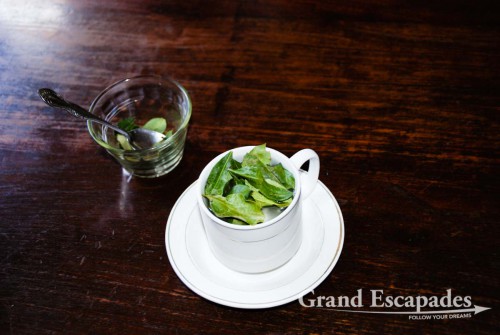The Yungas is an area north of La Paz which is best described as the transition zone between the dry Altiplano and the humid Amazon Basin. Coroico, a small sleepy village, is one of the major settlements in the region. We got a first glimpse of this village perched on the mountain slope with amazing scenery all around when biking down “Death Road”. We knew then that this was a place where we wanted to chill out for a few days.
Not that we were tired, but we were worried that moving constantly within a range of 4.400 meters of altitude might eventually have an effect on our bodies. After spending weeks above 3.800 meters in Peru, near Lake Titicaca and in La Paz, we went down to the Amazon Basin at 280 meters for ten days, then up to La Paz for just two days with one time at 4.640 meters and back down again to the Yungas at 1.750 meters.
Actually we both have coped rather well with the high altitude, even though it has been sometimes difficult to sleep around 4.000 meters, but that was as severe as it got. In Cusco, at only 3.200 meters, it is not uncommon that tourists have to be admitted to the hospital and giving oxygen.
There is a lot to do in Coroico, hiking, more mountain biking, horseback riding, which all seemed so tempting. But luckily it rained us on the first day, forcing us stay at the hotel, which was probably the wisest thing to do after all the recent activities and we really managed to nothing for a few days.
Here in the Yungas region, it was the first time that we saw a few black people. While traveling through Peru and Bolivia it seemed that the population was exclusively of Indigenous or Hispanic descent. So this caught our attention. There are about 35.000 Afro-Bolivians who descended from African slaves that were brought to Bolivia to work in the silver mines of Potosi, where they died in astronomical numbers. Actually there is a village here called Torano, where only black people live. It has already found its way into the travel itineraries.
One day we hired a taxi to take us to coca and then to coffee plantations. Our taxi driver, a graduate of the University of Agriculture in Carman Pampa, therefore also served as knowledgeable guide for those almost three hours. And this is what we learned.
The Yungas is the region that produces the best coca leaves, which are sold throughout Bolivia. There are different plants of coca, and the lower bushes are the one producing the highest quality of leaves. Of the four harvests per year, the first harvest is also the one producing the highest quality. One kilogram of Coca leaves costs approx. 40 Bolivanos or 4 Euros … Our “guide” explained us that one field could bring as much (or actually as little) as 2.000 Bolivanos or 200 Euro per year. We watched some farmers pick the leaves. It is hard work in this heat, a field also requires tending, for example weed needs to be removed.
By the way, coca leaves are sold legally in Bolivia and we have started most of our days with a cup of Mate de Coca. It is served in teabags or the very leaves. Just chewing coca leaves does not have any effect. It needs to be taken with an alkaloid to extract the stimulating substance from the leaf: this is usually made of mineral lime, potato and quinoa ash.
We then took a road that remembered us very much of the “Death Road”, but for the fact that this one was only linking Coroico to a smaller city, Carmen Pampa. There we had a chance to visit a coffee plantation as well as a processing plant. We got to see coffee in every possible form and stage of processing: from the red and yellow mature beans still on the tree to grinded coffee with an extreme strong aroma.






No comments yet.